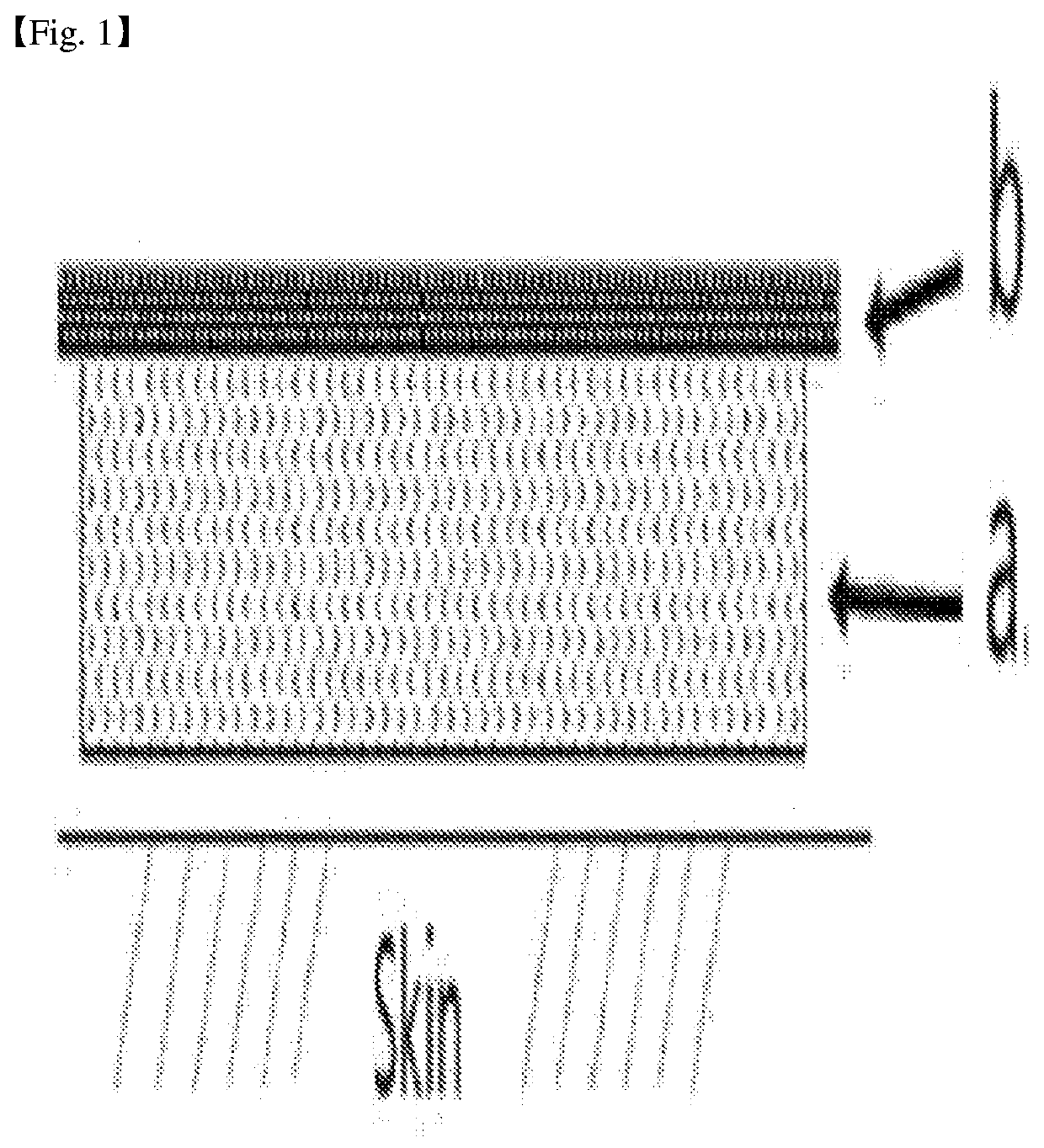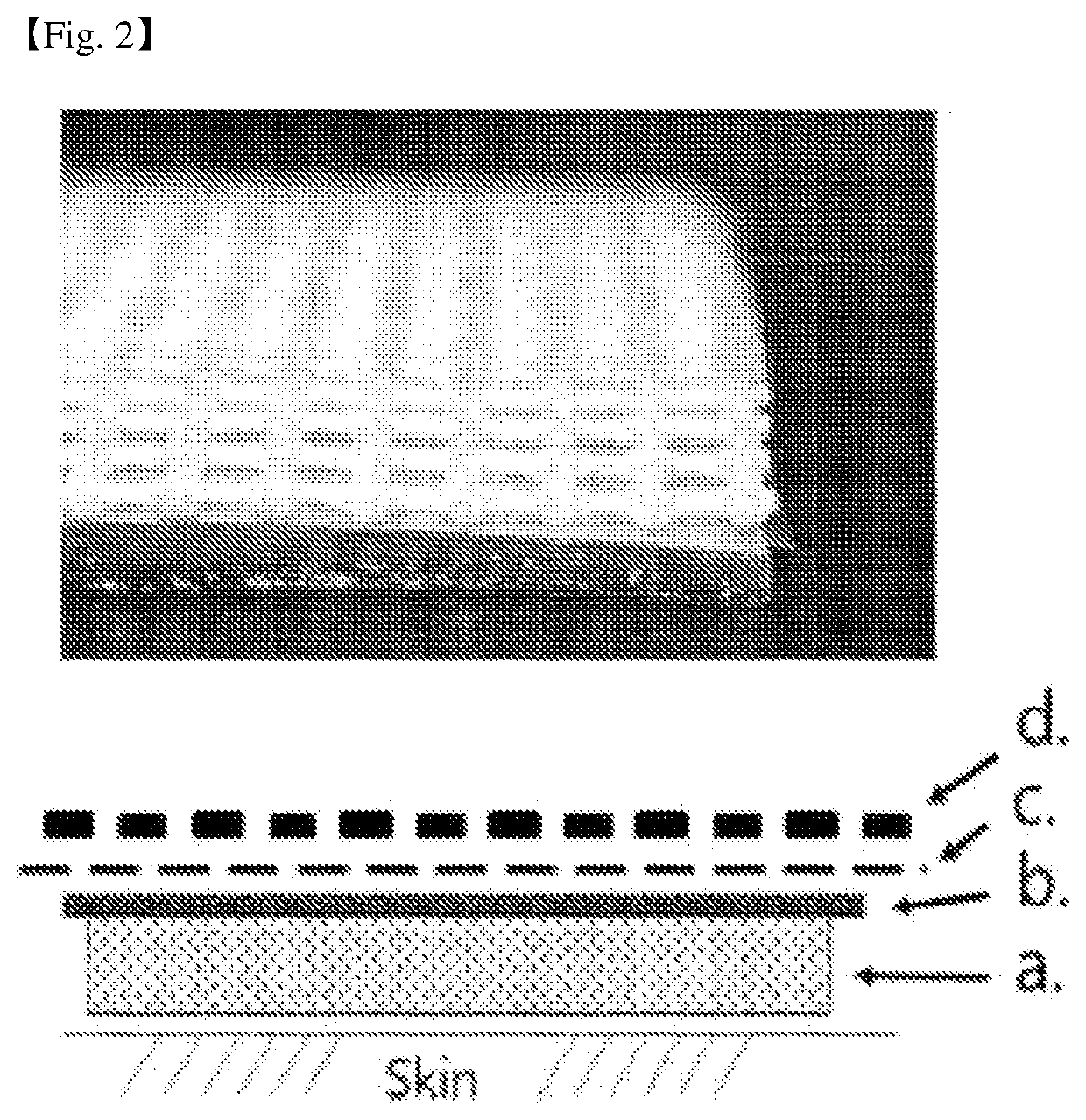Pad for alleviating and treating plasma protein exudation skin diseases including atopic diseases
a technology of plasma protein and skin diseases, applied in the field ofpad, can solve the problems of affecting the arrangement structure of surrounding epidermal fat, affecting the function of the skin barrier function of the epidermal fat, and affecting the restoration function of the epidermis, so as to reduce the concentration, facilitate the discharge, and reduce the temperature of the epidermis
- Summary
- Abstract
- Description
- Claims
- Application Information
AI Technical Summary
Benefits of technology
Problems solved by technology
Method used
Image
Examples
example 1
on of the Pad of the Present Invention
[0067]The pad of the present invention was prepared by putting 2% (w / v) agar in a 50% NaCl solution (about 70 mM) of saline, autoclaving (121° C., 151b / cm2, 15 min) and then pouring it into a mold to be a thickness of 2 mm, when cooled at 60-70° C. When the agar solution was maintained in the liquid phase (about 55-70° C.) before hardening, fibers (paper, thin cotton, fiber, etc.) were placed on the surface and cured together with the agar gel so as to be united. After the agar gel was completely hardened, the agar film, which occasionally climbed over the fibrous layer and hardened to form, was scraped off with a flat, sharp tool to remove it clearly.
[0068]In preparing the pads containing the various compositions described in Table 1 in addition to the basic pads of the present invention, when the gel is in the liquid phase before hardening it (55-70° C.), the components to be required (for example, organic acid, lecithin, and the like, as desc...
experimental example 1
al Temperature and Epidermis Cooling Effect of the Pad
[0069]The temperature change of epidermis was monitored using a wireless temperature sensor (SL52T data logger, Signatrol, UK). In order to confirm the effect of the pad on lowering the epidermal temperature, the temperature change was determined for each of cases that temperature sensor was placed on the skin inside the normal forearm, and then covered with two layers of gauze, and that the temperature sensor was placed on the skin, and then the pad (6×8 cm, 2 mm thickness, 50% NaCl concentration) was placed on the it. In addition, in order to confirm the continuous effect of pad on skin cooling, the temperature changes were compared using nonwoven fabrics (6×8 cm) for a mask pack, socked with a salt concentration solution of 50% physiological saline. Experiments were carried out at room temperature, and the mean room temperature at the time of the experiment was 25±1° C. and the mean relative humidity was 30%. Each of gauze, pa...
experimental example 3
of the Present Invention for Lowering the Epidermal Temperature
[0076]When the pad is applied to the epidermis, the effect is shown that the epidermal temperature of the applied area is lowered by about 6° C. under the environmental conditions fixed given in the laboratory. Occasionally, a user may feel cold due to a rarely lowered temperature difference. To alleviate this discomfort, it is necessary to control the degree of lowering of the epidermal temperature by adjusting the moisture evaporation amount of the pad. It is possible to control the lowering of the epidermal temperature by attaching a polyvinyl film perforated at constant intervals to the surface of the pad and controlling the moisture evaporation. When moisture evaporation was measured at the surface of the hot plate set at 32° C., the evaporation rate of moisture was reduced by 64% when the pads were covered with the vinyl film perforated in the area of 30%, and when the pads were covered with the vinyl film perforat...
PUM
| Property | Measurement | Unit |
|---|---|---|
| time | aaaaa | aaaaa |
| thickness | aaaaa | aaaaa |
| thick | aaaaa | aaaaa |
Abstract
Description
Claims
Application Information
 Login to View More
Login to View More - R&D
- Intellectual Property
- Life Sciences
- Materials
- Tech Scout
- Unparalleled Data Quality
- Higher Quality Content
- 60% Fewer Hallucinations
Browse by: Latest US Patents, China's latest patents, Technical Efficacy Thesaurus, Application Domain, Technology Topic, Popular Technical Reports.
© 2025 PatSnap. All rights reserved.Legal|Privacy policy|Modern Slavery Act Transparency Statement|Sitemap|About US| Contact US: help@patsnap.com



